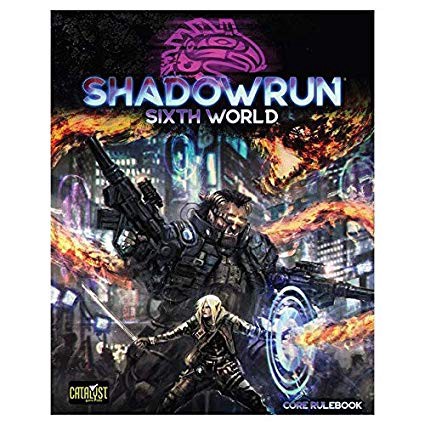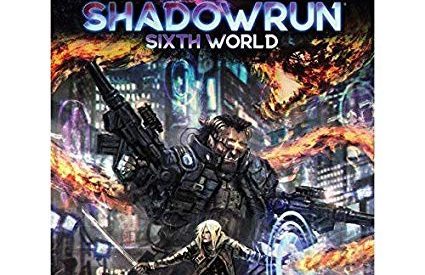
Shadowrun is a game system that has been around for years now, but admittedly it had passed me by. My history of RPGs has been primarily focused on D20 systems, with a brief holdover in the odd D6 system of Iron Kingdoms (basically a D20 system in drag). I?ve recently been introduced to dice pool systems through Kieron Gillen?s DIE and some podcasts that have used the Powered by the Apocalypse system, so when I happened to see a copy of the Shadowrun, Sixth World Beginner?s Box I scooped it up. After all, they seemed to be going out of stock left and right in Chicago, and a good friend of mine was absolutely ravenous about the setting.
The setting is simple enough to explain: At some point in the future, Magic happened. When it happened, it warped some humans into meta-humanity (orcs, trolls, elves, dwarves), and now there are people who can be mages again. Alongside that, the internet slowly evolved into the Matrix (basically the movie, but? less? dystopian?) because of AR and VR. While that was happening, Capitalism went full crazy so now there are mega-corporations that are basically just countries. Honestly its a pretty generic cyberpunk narrative with some fantasy thrown in for flavor? but not too much.
It seemed simple enough: Some premade characters, some useful cards for abilities, enemies, spells, etc., an admittedly cool set of dice, a brief adventure, and some quick start rules. The rules are pretty straight forward, stats are the number of D6 you can roll for tests related to them. To succeed at a test, you have to roll a number of 5s and 6s equal to or higher than the threshold.This includes combat, which is just handled as a series of similar tests rolled against each other. Unfortunately, this gets ridiculously out of hand pretty regularly as players are rolling upwards of 20 dice for individual tests, and is made even more complicated by the inclusion of Edge.
Edge is an abstraction of the advantages you manage to accrue in a given situation (fighting a guy in the dark where you have night vision and he doesn?t, things like that), and its the main feature that makes Shadowrun stand out from the pack. You gather up Edge through clever plays and a related Edge stat. It allows you to manipulate your rolls in ways such as re-rolling, modifying individual dice rolls, negating enemy edge, healing? the list is LONG, and it complicates every aspect of the game in interesting ways.
And that isn?t a bad thing. A complicated game can be a lot of fun if that?s the kind of thing you?re looking for. To Catalyst?s credit, the Beginner?s box does an excellent job of explaining the system for new players. While it took me a moment to understand how accumulating Edge worked, spending it was plainly obvious. In fact, the Beginner?s box is excellent about filtering complicated game concepts into easily understood and digestible ideas for new players.
This is reinforced in a lot of ways, but the most impressive of these is the artwork. While many games (Dungeons and Dragons, Path/Starfinder in particular) will use original characters in bland heroic poses as visual representations of classes, Shadowrun has their characters actively engaged in their role in every image of them in the Beginner?s box. Zipfile is only shown engaging with technology, Frostburn is drowning the page in flames, Yu is looking smooth and suave, and Rude? well, he?s just looking brutal with a giant ?get out of my face? sword. It perfectly informs you with a single glance what these characters do and what their role is in the game, while also giving you a bit of insight into their personalities. Combined with cards for spells, items, and enemies, as well as dossiers for each character that include their character sheets, motivations, methods, and a crash course in all of their relevant rules, players and the GM are able to easily learn and reference everything they need to play a game. It makes the entire game seem incredibly simple.
And then I bought the Core Rulebook.
While physical copies of the rulebook are currently unavailable at time of writing (shipping issues have delayed the physical release until roughly October), PDFs are available on their website (https://store.catalystgamelabs.com/collections/shadowrun/products/shadowrun-sixth-world-core-rulebook) and DriveThruRPG.com (https://www.drivethrurpg.com/product/286850/Shadowrun-Sixth-World-Core-Rulebook) for about $20. If you end up purchasing the PDF, Catalyst will give you a discount on a physical copy when they come out, which is nice.
The Core Rulebook takes the relatively simple rules explained in the Beginner?s Box, and RUNS WILD WITH THEM. The core of the game (tests and edge) are the same, but character creation, magic, and matrix are greatly expanded on, to a mind-blowing degree.
First, let?s take a look at Character Creation. If you look at the Beginner?s box, it?s easy to think that classes are clearly separated? you would be wrong. In fact, Shadowrun has one of the most interesting character creation systems I?ve ever seen: It?s classless. You don?t choose a class for your character. Ever. First, you decide on your role (Arcane Expert, Tech Expert, Face, and Street Samurai). This doesn?t have any mechanical effect, it just gives you an idea of what you?re aiming for. Next, there is a priority table from which you pick a single row per column (columns being Metatype, Attributes, Skills, Magic/Resonance, and Resources), based on what you think is a higher priority for your character, and then a little Karma to spend on rounding things out. It?s an interesting system that gives you a STAGGERING amount of control over your character build, and helps to mitigate the usual issues of players being able to make unplayable characters? but it doesn?t erase them. This is combated by the Archetypes, basically premade builds that let you fill broad character types in an effective manner. Its a solid method to essentially make classes optional, encouraging players to theorycraft but giving them a rough baseline to strive for.
The magic system has a similar amount of complexity, though less customization? well, slightly less. Magically inclined characters choose a tradition, which gives a little flavor to your spells and lets you choose what stat is most relevant to your casting. This is currently limited to Logic and Charisma, but it isn?t hard to imagine this being expanded to include just about any stat over time. From there, the core rules of magic in this universe are established: Magic and Technology don?t mix, casters need to have an arcane lodge (Magic house) where they can be magically safe and study new spells, and casting spells causes Drain (damage brought on by casting spells that can be resisted).
Spell casting is simple: You make adjustments to your spell, You make a test (Sorcery + Magic), and then you deal with the drain damage through another test (Tradition stat + Willpower).
Adjustments are simple; there are only three. You can Amp Up a combat spell, Increase the area of a spell, or shift the area of certain spells. Amp Up and Increase Area increase the drain of the spell by 2 and 1 respectively, but shifting the area doesn?t. They?re all pretty self explanatory: Amp Up increases damage, Increase Area makes the AoE bigger, and Shift Area moves the spell around. From the look of it, you can apply a technically infinite number of adjustments, limited only by your ability to survive the casting.
From here we get into the fun part of a magic system; The spells. They?re separated into a variety of groups based on use rather than vague and poorly defined schools: Combat spells, Detection spells, Health spells, Illusion spells, and Manipulation spells. There?s a lot of fun things to play around with in here, but the magic system doesn?t stop there.
There?s also counter-spelling, split into boosted defense and dispelling. Boosted defense essentially adds temporary hit points to anyone within the radius to be used against spells cast at them, based off of a Sorcery + Magic test. Dispelling is pretty self explanatory, removing a spell that has been cast on the area through a similar roll against the drain value of a spell x2.
There are a lot of other pieces to the magic system such as rituals, conjuring, enchanting, foci, and just? so, so many more that I don?t have time to cover if I want to get to The Matrix and Rigging. This might by one of my favorite magic systems in any game I?ve played yet.
The Matrix refers to a mix of AR and VR, and since its stat, Resonance, is the alternate to Magic, it?s easy to think that messing with the Matrix is just a re-skinned Magic. That assumption is hilariously incorrect. Dealing with the Matrix is essentially a combat mini-game, complete with it?s own initiative and moves, all requiring a variety of checks. I can?t adequately or quickly explain most of this, it?s easily over my head at the moment. It took me over a week to sort out character creation and magic, each. There are a series of Matrix actions, as well as basic and hacking programs, as well as hosts that act as locations within the Matrix all with their own stats and ratings, IC programs that act as security that use the stats of their host, and then Technomancers are pseudo-casters that can access The Matrix without technology but act as magic users for the Matrix? I?m admittedly still wrapping my head around it, because it is probably the most complicated thing in this entire game.
This game is really exciting. I?m a huge fan of the customization options available, and I can?t stress enough how much I love the magic system. But many of the systems are a mind-blowing network of complex mechanics that almost feel contradictory, and the number of D6 required to make rolls is frankly obscene. If you?re going to start this game, you almost need the beginner?s box to create a framework for easing into the other mechanics. Which also gives you a bunch of extra D6 themed specifically to the game which is nice. If you go with the PDF of the rulebook and grab the Beginner?s Box at MSRP, starting this game in a way that is understandable will only cost you about $45 ($75 if you go with the physical book when it comes out in October), which is a pretty decent starting price and makes me a little more inclined to recommend this game.
If you?re inclined towards high levels of character customization and a dense, rewarding game system, definitely give this one a look.
If you prefer a system that?s a little less dense, and one that doesn?t rely so heavily on its own lore, then you can probably skip this one.
EDIT: When this article was released, one of the biggest issues with the core rulebook was editing: information was spread across the entire book in odd ways, and information vital to specific mechanics was missing from the book. Since then, an updated rulebook has been released that fixes many of these issues.


